Core to the Point
Welcome to the first week of Core Set 2020 previews. This week, I'm going the talk about the design of the set and then show off three preview cards. I should start by stressing that I had nothing to do with the design of this set, as it did not have separate Vision Design and Set Design teams. The whole design was run by Yoni Skolnik, who I talked with to get the full story behind the set's design.
The Core, the Merrier
Core Set 2020 design started by looking back at the design of Core Set 2019. After a multi-year hiatus from the core set, we'd made the choice to return to it, and Core Set 2019 was our inaugural attempt at crafting a new core set. Yoni and his team began by examining what Core Set 2019 had done well.
Accessibility
One of the main reasons we'd chosen to return to making a core set was the need to have a product that served as a good on-ramp for new players. The normal Standard-legal sets are fun, but they're aimed more at the current player than the novice and, as such, can be a bit intimidating for newer players. The core set helps newer players in two big ways: a lower complexity level and a higher resonance level. The former is about being more careful with how many mechanics the players are expected to interact with. The latter is about making the cards as approachable and recognizable as possible. These two things combined help create the most inviting set we can for players sampling the game for the first time. Core Set 2019 had done a good job of being accessible, and Core Set 2020 was interested in doing the same.
Introductory Product Integration
The core sets aren't the only products aimed at beginners. In fact, we have what we call a beginner product pathing, that is a suite of products designed to be played in a certain order to help ease new players into the game. First are the Welcome Decks. These are free monocolor 30-card decks given away at stores. The welcome decks are a zero-risk opportunity to sample the game. Next are the Planeswalker Decks. Built around a planeswalker card, these preconstructed decks allow players to experience a more fully fleshed out deck complete with mechanical themes. This is followed by the Deck Builder's Toolkit, a product that gives the players a whole bunch of cards grouped around themes that let the player have their first chance at building their own deck. Lastly is the core set, which is the first booster pack–centered product meant to introduce the trading card aspect of the game.
In the past, we designed the Welcome Decks, Planeswalker Decks, and Deck Builder's Toolkits after the fact, making use of whatever core set cards we could. Core Set 2019 completely changed this model. Rather than design the first products that players see as an afterthought, we wove their design into the design of the core set. What this meant was the core set design team wasn't just making the core set but rather all four products at once, allowing them to make sure that everything they needed for all the products was addressed and integrated as the core set was designed. (We also allowed the ability to design some cards—usually very simple, basic cards—specifically for the beginner products that would be connected with the core set without being in the core set boosters.) Core Set 2019 had done this very well, and Core Set 2020 wanted to follow in its footsteps.
No Non-Evergreen Keywords
Starting with Magic 2011, the core sets brought back a simple non-evergreen keyword (Magic 2011 was scry, Magic 2012 was bloodthirst, Magic 2013 was exalted, Magic 2014 was Slivers, and Magic 2012 was convoke). Magic Origins, the final core set before we retired them, introduced two new keywords (renown and spell mastery), the first time ever for a core set (okay, other than Limited Edition Alpha and Beta). Core Set 2019 made the decision to pull back and not bring back an old keyword (although, technically, it did have one mythic rare—Nicol Bolas, the Ravager/Nicol Bolas, the Arisen—which used transform). Core Set 2020 decided to continue what Core Set 2019 had done.
Small Flavor Theme
The core sets don't reference the current storyline, but Core Set 2019 did choose one character important to the story, Nicol Bolas, and focused on his past. Core Set 2020 was in a bit of a different place than Core Set 2019, though, as a major storyline had just wrapped up, so it decided to have a small flavor theme with a lighter touch than Core Set 2019.
Five Monocolored Planeswalkers
Ever since the planeswalker card type had been introduced to the game, the core set has had (at least) five monocolored planeswalkers as a means to introduce newer players to the concept of planeswalkers, a central component of Magic's brand and storyline. Core Set 2019 had five monocolored planeswalkers, plus a double-faced Nicol Bolas that turned from a creature into a planeswalker. Core Set 2020 wanted to repeat having five monocolored planeswalkers (although, not all the same ones) along with a new twist which I will be getting to.
While there was a lot the Core Set 2020 design team liked about Core Set 2019, they felt there was room for improvement in a few areas.
On Draft
The biggest area the Core Set 2020 design team was interested in improving was the Limited and Draft experience. Core Set 2019 was built around having ten two-color Draft archetypes. A few of them, such as white-blue's "artifacts matter" theme and green-white's "Auras matter" theme, were very insular and hard to combine with adjacent Draft themes. This resulted in the play design problem of positioning the cards power-wise. If they made them too strong, the archetype becomes overpowered if only one person is drafting it (as the other drafters have no reason to take the cards), and if they made them too weak, no one ever drafts the archetype. The non-core sets have the advantage of new mechanics which can help overlay themes between needed colors (for example, if blue and red need more Draft strength, you can choose to make those two colors the major colors of a new mechanic), but core sets with only the evergreen keywords to work with don't have those tools.
Yoni, with experience building Draft archetypes having lead the set design for Masters 25 and Ultimate Masters (masters sets require a very unique skill of crafting Draft environments out of preexisting components as the sets only use reprints), came up with a novel approach to solve the problem. What if the set was built around three-color groupings?
Core Set 2019 had a cycle of three-color "arc" (a color and its two allies) legendary Dragons. These were designed to be flavorful cards to be built around and to add some Commander excitement to the set. To differentiate Core Set 2020 from Core Set 2019, Yoni liked the idea of focusing on three-color "wedge" (a color and its two enemies) legendary creatures. If he did this, that meant his Draft three-color groupings would have to be wedge (red-white-black, green-blue-red, white-black-green, blue-red-white, and black-green-blue).
Having chosen to use wedge combinations, Yoni and his team decided to focus the five themes strongly on the ally-colored pairs within each wedge (each wedge combination has only one ally pair), with the enemy color being a bit softer in the theme. This way, you could draft the ally pair to play the theme in two-color or add in the enemy color to play it in three-color. Here's how the themes played out:
Flying (blue-red-white)
The first theme they began with was flying. White-blue is traditionally one of the hardest themes to build around for beginners as it leans towards a reactive control strategy, which, while popular with experienced players, is very hard for beginners to wrap their head around. Flying, in contrast, is pretty straightforward. Play your evasive creatures and attack. Luckily, flying is primary in white and blue. This meant the third color with the theme would be red. Red doesn't normally have a ton of flying (usually just Dragons and Phoenixes), but enough that they could ratchet it up slightly without being too much of a color pie bend.
Elementals (green-blue-red)
Elementals as a creature type shows up in all five colors, but primarily is a red and green thing (red and green make up almost seventy percent of monocolored Elementals, as an example). Interestingly, blue is the third most common Elemental color (as blue is the color of air and water to red's earth and fire). This made it a good fit for the green-blue-red wedge. Elementals was also a nice theme because it tied directly to Chandra who was the main face of the set. (More on her below.)
Go Wide (white-black-green)
Green and white are the top two colors in both creature percentages and token making (green and white account for over fifty-five percent of all token making on monocolored cards), so it felt right to focus that color pair on a "go wide" strategy. "Go wide" means a creature-based strategy, often making use of tokens, to overwhelm the opponent by attacking with a huge number of creatures. "Go wide" strategies lean on making creatures and then effects that buff the whole team (also an ability focused in white and green). Black just so happens to be number three both in creature percentages and token making, which made it the perfect choice to be the third color.
Aggro (red-white-black)
This one was a little trickier. Most Magic sets like having an aggro strategy ("aggro" defined as using all your mana every turn to play creatures which constantly attack, trying to win the game as quickly as possible before the opponent can stabilize). White, red, and black are the three colors most associated with aggro strategies, but the two-color pair most connected with aggro is red-white. That's an enemy color, not an ally one. The idea for Core Set 2020 was to shift aggro from primarily red-white to primarily black-red with white serving as the third color. This required rethinking how some of the white and black creatures were positioned but was an attainable theme.
Control with "Enters-the-Battlefield" Effects (black-green-blue)
As I explained above, control strategies can be tricky for newer players. Yoni and his team decided that blue-black might be a better place to put the control deck as it's more based on doing things and less on reacting. Blue and black can both have creatures with "enters-the-battlefield" effects (ETBs), which can help control the battlefield in a more proactive way, something newer players can see even if they don't understand the card-advantage strategy behind it. They paired this with green as it has a larger creature focus, which plays well with ETBs. The one other reason this theme worked well was that the other four themes were all creature based, so using ETB-effect creatures allowed for more cross-theme synergy.
Now that we've walked through the themes, let's talk a little bit about how these themes enable the draft. There are three different approaches drafters can take when drafting.
First, they can draft any ally-color pair. Each has a strong theme that's loudly expressed on the cards. Second, they can use a three-color strategy where they draft a wedge. Again, each of the five wedge strategies revolve around the ally-color pair themes with an added support of the enemy color. Third, they can draft an enemy-color deck. These decks are a cross between two themes because any enemy combination will have one color that's primary in theme A and secondary in theme B, while the other color will be primary in theme B and secondary in theme A. Let's take blue-red as an example.
Blue is primary in flying and secondary in Elementals, while red is primary in Elementals and secondary in flying. Early on, you pick up a blue Elemental flier. Obviously, you can combine it with white to make a two-color flying deck or red and white to make a three-color flying deck, or you can combine it with red and green to make a three-color Elemental deck. You also have the choice, though, to pick up just red cards and draft both "flying matters" (as red is secondary in flying) and "Elementals matter" (as red is primary in Elementals) cards. Each of the themes were designed such that they interacted with the theme of the enemy color.
Also, because the set had only five themes, that left a bit of space to allow Yoni and his team to design a number of build-around cards, usually at uncommon, that would allow the experienced drafters the ability to draft some more offbeat decks with the set.
Plane(swalker) and Simple
Another problem the design team had to face was how to add a little extra spice to the set with its planeswalkers. Core Set 2019 had done a double-faced card with Bolas, but Core Set 2020's main focus was Chandra, and she'd already had a double-faced card in Magic Origins. What could we do to make Chandra shine? The answer came from a suggestion by Magic Senior Director Aaron Forsythe.
War of the Spark had introduced uncommon and rare planeswalkers to the game (okay, the original Lorwyn planeswalkers were rare, as mythic rare hadn't happened yet) which opened up an interesting opportunity. What if the set didn't have one Chandra, but three? Core Set 2020 could have an uncommon Chandra, a rare Chandra, and a mythic rare Chandra.
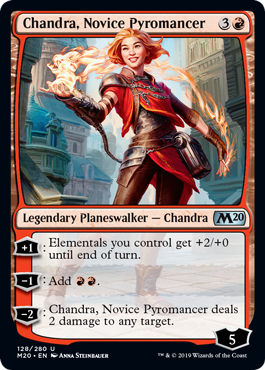
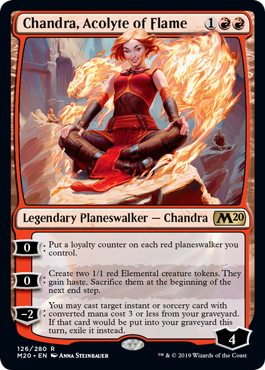
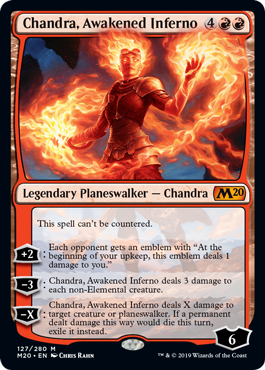
This would allow players the opportunity to do something they don't often get to do in Standard—play a planeswalker-themed deck. You see, the following five cards are already in Standard:
Besides the three planeswalkers, there are four other Chandra-themed cards in Core Set 2020, two of which are my preview cards for today. First up is Chandra's Embercat.
Click here to meet Chandra's Embercat
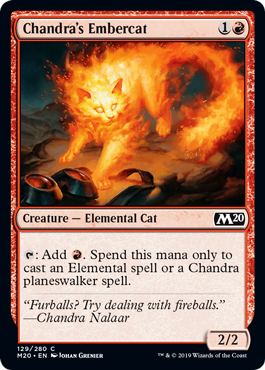
As you can see, this card is not only Chandra themed but also mechanically tied to both Chandra planeswalker cards and Elementals (although, in a Chandra-themed deck, you might want to just play Elementals made of fire).
Next is Chandra's Regulator. Longtime story fans might recognize the device Chandra got from her parents to help control her pyromancy.
Click here to see Chandra's Regulator
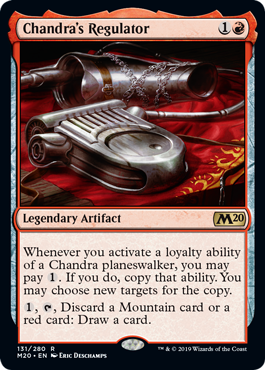
This is a colored artifact (more on that next week) that combos with both Chandra planeswalkers and red cards/Mountains. It's the kind of card that goes great with a deck full of Chandras.
My last preview isn't technically Chandra themed, but it's flavorfully on point for a Chandra deck and plays nicely with my other two preview cards.
Click here to meet Cavalier of Flame
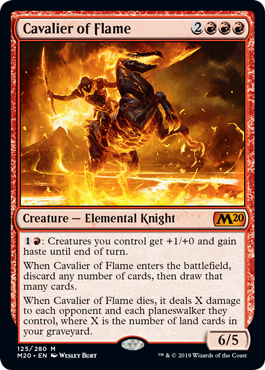
The Cavalier of Flame is part of a mythic rare cycle (which I'll also talk about next week). It's the kind of creature close to Chandra's heart.
I'm hoping all the Chandra fans out there are excited by the cool Chandra deck Core Set 2020 is going to enable.
Good to the Core
That's all the time I have for today. There's a bunch more to say about the set, but luckily, I have a whole other article next week to talk about it along with a bunch more preview cards. I'm hoping today's article whet your appetite for Core Set 2020. As always, I'm interested to hear any feedback on today's article, on any of the cards I previewed, or on Core Set 2020 itself. You can email me or contact me through any of my social media accounts (Twitter, Tumblr, and Instagram) with your thoughts on any of the above.
Join me next week for more on the design of Core Set 2020.
Until then, may you have fun starting to plan your Chandra deck.
#645: Languages
#645: Languages
31:17
Magic is printed in eleven languages. In this podcast, I talk about how that came to be and how making a game printed in so many languages impacts game design.
#646: Seeing the World
#646: Seeing the World
52:18
Working on Magic has taken me to many countries around the world. In this podcast, I reminisce about all the places I've visited on Magic's dime.
- Episode 644 Ajani's Pridemate
- Episode 643 Breaking Rules
- Episode 642 Retired Mechanics

